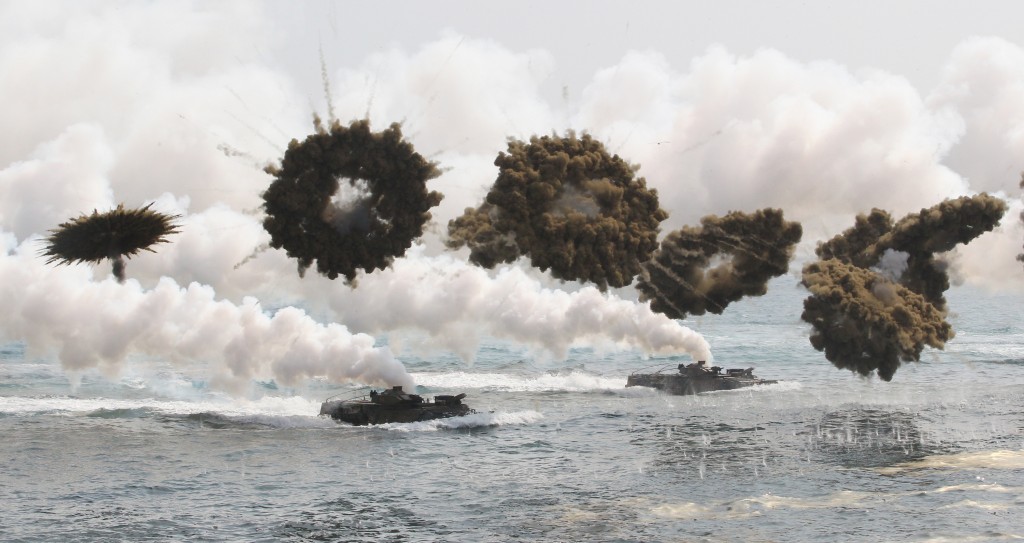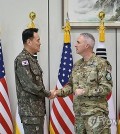- California Assembly OKs highest minimum wage in nation
- S. Korea unveils first graphic cigarette warnings
- US joins with South Korea, Japan in bid to deter North Korea
- LPGA golfer Chun In-gee finally back in action
- S. Korea won’t be top seed in final World Cup qualification round
- US men’s soccer misses 2nd straight Olympics
- US back on track in qualifying with 4-0 win over Guatemala
- High-intensity workout injuries spawn cottage industry
- CDC expands range of Zika mosquitoes into parts of Northeast
- Who knew? ‘The Walking Dead’ is helping families connect
Tensions grow as joint drills begin

FILE — South Korean marine LVT-7 landing craft sail to shores through smoke screens during the U.S.-South Korea joint military exercises called Ssangyong, part of the Foal Eagle military exercises, in Pohang, South Korea, March 31, 2014. (AP, file)
By Jun Ji-hye
Tension is escalating after North Korea threatened to launch an all-out offensive in response to the largest-ever joint exercises by South Korea and the U.S., which started Monday.
The largely computer-simulated Key Resolve drill will run until March 18, and the Foal Eagle combined field training exercise will take place until April 30.
The National Intelligence Service said North Korea has attempted to hack into the smartphones of key South Korean officials and launched cyber attacks against a rail operator, without elaborating.
The agency plans to hold an emergency meeting on cyber security today to discuss how to deal with the increasing threats of the North’s hacking attacks.
Pyongyang vowed an all-out offensive Monday, further heightening tension on the peninsula, where a new form of Cold War is looming after the North’s fourth nuclear test on Jan. 6 and the launch of a long-range rocket on Feb. 7.
Seoul’s Ministry of National Defense hit back later in the day, saying that the South will respond resolutely and mercilessly to any provocations from the North.
President Park Geun-hye called on leaders of the military, during a meeting with her senior secretaries at Cheong Wa Dae, to show that the armed forces are capable of making the North pay the price for any additional provocations.
Approximately 17,000 U.S. forces are participating with over 300,000 South Korean troops in the two exercises, which are being conducted on an unprecedented scale with American B-2 stealth bombers, a nuclear submarine and the nuclear-powered John C. Stennis aircraft carrier.
The United Nations Command informed North Korea of the dates and the nature of the drills at 9:34 a.m. through its Panmunjom mission, the ROK-U.S. Combined Forces Command (CFC) said.
“Key Resolve highlights the longstanding and enduring partnership and friendship between the two nations and their combined commitment to Foal Eagle,” the CFC said in a release. “The Foal Eagle exercise implements a series of joint and combined field training operations conducted by the CFC and U.S. Forces Korea component commands (ground, air, naval, and special operations).”
The allies have included preparations for a contingency for preemptive strikes against the North’s key facilities in their war games this year as part of a the new joint wartime operational plan, dubbed OPLAN 5015.
They will also implement a joint deterrence strategy — coined the 4D strategy — “to detect, defend, disrupt and destroy” the North’s missile threats, containing nuclear, chemical and biological warheads. The 4D Operational Concept was approved during the allies’ annual Security Consultative Meeting held in Seoul during November last year.
Along with the two drills, marines and navy personnel of the two nations also began the biennial, combined amphibious exercise Ssang Yong 16, Monday, the CFC said in a separate release.
Some 122,000 U.S. Marines and sailors of the 3rd Marine Expeditionary Brigade, Expeditionary Strike Group 7 and Task Force 76 are participating in the exercise with some 5,000 ROK Marines and Navy personnel, as well as personnel from the Australian Army and New Zealand Defense Force, according to the CFC.
On Saturday, they will conduct a simulated amphibious assault along beaches in the vicinity of Pohang, during which they will penetrate notional enemy beach defenses, establish a beachhead, and deploy rapid transition forces and support on shore.
“This will be a simulated, full-spectrum, combined arms forcible entry operation,” the CFC said.
North Korea responded sensitively to the allies’ large-scale drills, apparently because of the fact that the exercises envision targeting key facilities and the leadership of the Kim Jong-un regime.
“The army and people of the (North) will take military counteraction for a preemptive attack so that they may deal merciless deadly blows at the enemies,” the North’s National Defense Commission said in a statement carried by the North’s official Korean Central News Agency.
The commission also warned that major South Korean targets are within the North’s firing range, and its nuclear strike capability can reach U.S. military bases within the Asia-Pacific region, as well as on the U.S. mainland.
In response, the Ministry of national Defense urged the North to “stop behaving imprudently, which will drive itself toward destruction.”
“If they launch provocations, we will respond resolutely and mercilessly,” said spokesman Moon Sang-gyun.
As part of the government’s efforts to punish the North for its continuous provocative actions, in addition to the newly adopted U.N. resolution sanctions, the government is planning to announce its own sanctions at 3 p.m. today..
The measures are likely to include a ban on vessels entering ports in South Korea from third-party countries that have travelled through the North, and sanctions on more institutions and personnel related to the North’s development of weapons of mass destruction in addition to those blacklisted by the U.N.
During the meeting, President Park Geun-hye called on her aides to take steps to ensure that U.N. member states can thoroughly implement the new sanctions as well as to impose additional sanctions on the North to rein in its nuclear and missile programs, referring to the U.N. Security Council’s unanimous adoption of a new resolution last week that contains sanctions meant to cut off the North’s access to hard currency.
“Now, what matters is to thoroughly implement the U.N. sanctions to make North Korea abandon its nuclear program and move toward change,” Park said Monday at the regular meeting with her senior secretaries.















